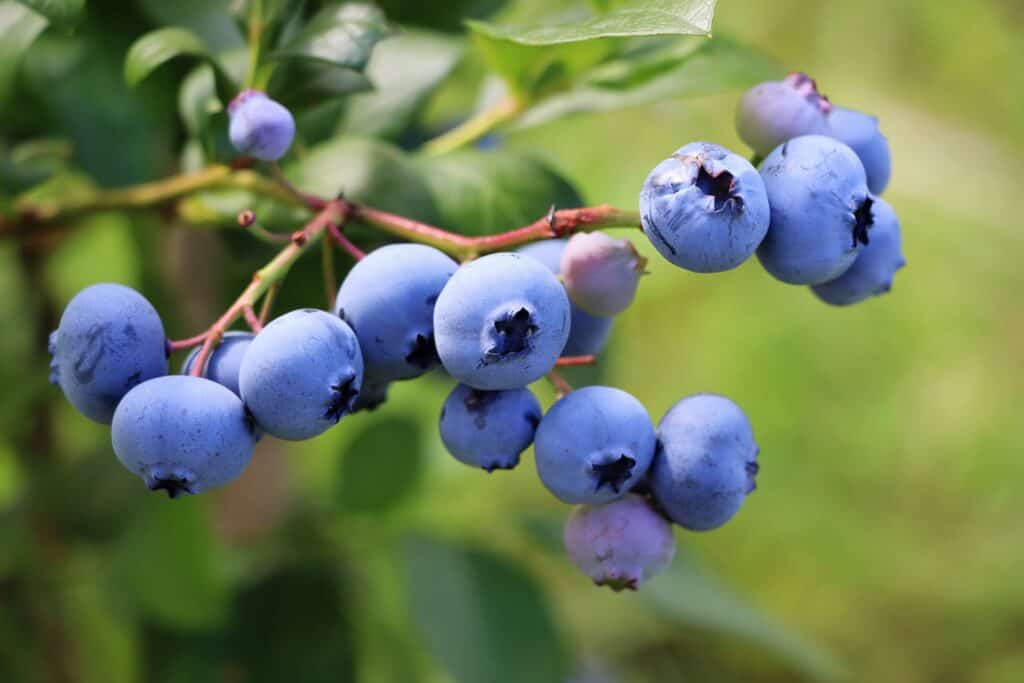Key Points:
- Highbush blueberries are bigger and more abundant than lowbush blueberries.
- Lowbush blueberries are smaller and a very dark blue, almost black.
- Lowbush blueberries are sweeter and more of a low-growing shrub, while highbush blueberries are tall crown-forming shrubs up to eight feet tall.
If you purchase blueberries from the grocery store, you may not know that there is more than one kind. Highbush blueberries that are large and medium blue are most often sold in grocery stores. But there is another kind of blueberry, often marketed as wild blueberries, called the lowbush blueberry. These are smaller, sweeter, and much darker in color. We will discuss the differences and similarities between these two types of blueberries in detail below.
Comparing Highbush Blueberry vs. Lowbush Blueberry

| Highbush Blueberry | Lowbush Blueberry | |
|---|---|---|
| Scientific Name | Vaccinium corymbosum | Vaccinium angustifolium |
| Common Name | Northern highbush, southern highbush | Lowbush, wild |
| Description and Size of Shrub | Taller. Grows to a height of 6-8 feet. Native plants can get up to 12 feet tall. Crown-forming bush, deciduous perennial. | Shorter. Knee-high. Grows 6 inches to 2 feet tall. Sprawling pattern with many twiggy branches. |
| USDA Hardiness Zones | Northern Highbush Zones 4-7 Southern Highbush Zone 10 | Zones 3-7 |
| Description of Berry | Mildy sweet and tart. Larger and lighter color blue. More berries per bush. | Strongly sweet and tart. Deeply blue, nearly black. Fewer berries per bush. |
| Growth Requirements | Acidic soil with a PH of 5. Full sun, well-drained site. Provide mulch | Acidic soil with a PH of 5. Full sun, well-drained site. Provide mulch |
Highbush Blueberry vs. Lowbush Blueberry: Key Differences
The main differences between these blueberries are highbush varieties grow taller and produce more abundantly. They also have larger, lighter-colored berries that are less sweet. Lowbush varieties are tiny, low-growing shrubs with dark blue and strongly sweet berries. We will discuss all of these differences in much more detail below.
Highbush Blueberry vs. Lowbush Blueberry: Name

The scientific name for lowbush blueberry is Vaccinium angustifolium.
©iStock.com/Nadya So
The scientific name for highbush blueberry is Vaccinium corymbosum. There are two common names, northern highbush and southern highbush.
The scientific name for lowbush blueberry is Vaccinium angustifolium. They are commonly called lowbush blueberry and wild blueberry.
Highbush Blueberry vs. Lowbush Blueberry: Appearance

Highbush blueberries grow six to eight feet tall and form a lovely bush with a tall crown.
©vaivirga/Shutterstock.com
Highbush blueberries are taller than lowbush blueberries. They grow six to eight feet tall and form a lovely bush with a tall crown. In the wild, you can find native highbush blueberries that are twelve feet tall! New leaves are red in the spring and then turn a blueish green during the summer. In the fall, the leaves are a brilliant bright red. Spring flowers are white or pink.
Lowbush blueberries are shorter than highbush blueberries. They rarely grow taller than knee-high and are sometimes as low as six inches. Lowbush blueberries grow in a sprawling pattern and have many twiggy branches. In the wild, they form a patch so dense that it crowds out all other plants. New leaves are light green, turning dark green in the summer and a reddish bronze in the fall. Flowers are bell-shaped and white.
Highbush Blueberry vs. Lowbush Blueberry: Berry
The highbush blueberry is a medium blue with dull powdery skin. It is mildly sweet and tart. Highbush blueberries yield an average of five to ten pounds of berries from each mature plant!
The lowbush blueberry is a dark blue, nearly black, with shiny skin. It is strongly sweet and tart. Lowbush blueberries yield an average of one to three pounds of berries from each mature plant.
Highbush Blueberry vs. Lowbush Blueberry: Growing
All blueberries prefer acidic soil with a PH of 5. If you do not have acidic soil, you can plant your blueberry bush in a raised bed and provide soil amendments to change the soil PH in that small area. Plant blueberries in an area with eight hours of sun per day in a site that has well-draining soil.
Blueberries have shallow roots; if you move the top one inch of soil aside, you will see fine hair-like roots searching for water and nutrients. For this reason, it is essential to plant in a weed-free environment and provide mulch to protect the roots. Fertilize once per month with a solution rich in phosphorus and potassium.
Up Next:
The photo featured at the top of this post is © Bukhta Yurii/Shutterstock.com
Thank you for reading! Have some feedback for us? Contact the AZ Animals editorial team.






